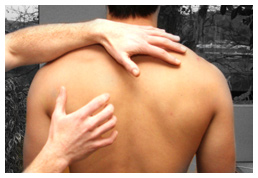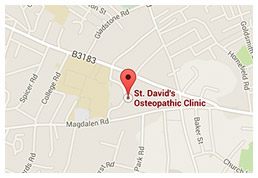What is Osteopathy?
Osteopathy is a primary care profession, focusing on the diagnosis, treatment, prevention and rehabilitation of musculoskeletal disorders and back pain, and the effects of these conditions on patients' general health.
Osteopathy is based on the principle that the body has the ability to heal, and osteopathic care focuses on strengthening the musculoskeletal systems to treat existing conditions and to prevent illness.
Osteopathy recognises the importance of the link between the structure of the human body and the way it functions. Osteopaths focus on the body’s skeleton and joint function along with the underlying muscles, soft tissue and internal organs.
Utilising a highly developed sense of touch, they identify problem areas of the body. Using gentle stretching and mobilising techniques as well as manipulating joints, an osteopath works with the body to create the perfect conditions to facilitate the healing process.
Treatment usually consists of a combination of soft-tissue releasing techniques, and some specific adjustments affecting joints and soft-tissues (muscles, tendons and ligaments). Advice can also be given on self-help treatments.
Cranial Osteopathy
Cranial Osteopathy is a very gentle hands on in technique. The Osteopath uses subtle movements to diagnose and correct tensions/stresses throughout the body, thus restoring the structure function relationship of the related components.
Cranial technique is very suitable to patients who prefer a gentler approach and is used in the treatment of babies and children. It is an extremely effective approach and may be used in a wide range of conditions for people of all ages, from birth to old age.
What happens?
On your first visit, a full medical case history will be taken. An examination will be carried out (you may be asked to remove some clothing for this) and you may then be asked to perform a few simple movements so the osteopath can assess the problem.
The osteopath will use their highly developed sense of touch called palpation to assess areas of weakness, tenderness, restriction or strain within your body.
The osteopath will make a diagnosis and discuss it with you and if osteopathic treatment is suitable it will be offered to you. Treatment will be aimed at helping to restore normal joint stability and function.
Osteopaths usually start any treatment by releasing and relaxing muscles and stretching stiff joints, using gentle massage techniques, rhythmic joint movements and muscle release techniques. The osteopath may also carry out manipulation using short, quick movements to spinal joints. Other techniques may also be used depending on your problem.
Treatments usually last up to half an hour, and normally between 2 and 6 sessions are required. Many patients decide that they would like to have periodic preventative treatments to avoid recurring problems


